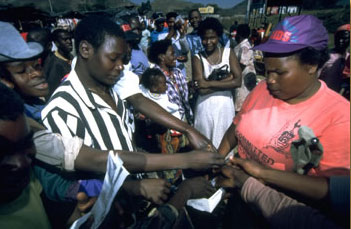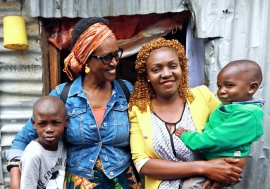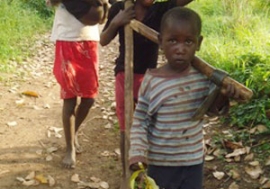Progress in Zimbabwe’s HIV/AIDS battle
Progress in Zimbabwe’s HIV/AIDS battle
 An AIDS worker distributing free condoms in Mutare, Zimbabwe: Behavioural changes have contributed to declining infection rates in the country.
An AIDS worker distributing free condoms in Mutare, Zimbabwe: Behavioural changes have contributed to declining infection rates in the country.Despite serious economic and political challenges, Zimbabwe has become only the second country in sub-Saharan Africa to significantly slow the spread of HIV, the human immunodeficiency virus that causes AIDS. In a brief press statement on 10 October, the Joint UN Programme on HIV/AIDS (UNAIDS) announced that infection rates among a particularly vulnerable group — pregnant women — declined from 24.6 per cent in 2002 to 21.3 per cent in 2004.
The findings are good news in a country with one of the highest HIV infection rates in the world. It is an indication, UNAIDS Advocacy, Communication and Leadership Director Achmat Dangor said, that education and prevention programmes launched during the 1990s are beginning to show results. “For us,” he noted, “that is very significant.”
During an exclusive interview with Africa Renewal in New York in late October, Mr. Dangor, a noted South African novelist and former head of the Nelson Mandela Foundation, also reported that infection rates among young people, another group at high risk, have dropped even further, from about 25 to 20 per cent.
Despite the impressive progress, he cautioned, “this is no reason for complacency. Zimbabwe still has one of the highest HIV prevalence rates in the world.” The challenge now, he said, is to build on those gains.
Pinpointing the causes
Zimbabwe is only the second African country, after Uganda, to reduce very high HIV rates through education and prevention. Continued reductions in Zimbabwe, which is at the geographic and epidemiological centre of the AIDS pandemic in Africa, could mark a turning point in the struggle against the disease and offer valuable lessons to other countries in the region.
Given the difficult circumstances in Zimbabwe, Mr. Dangor said, when evidence of a decline in new infections began to arrive, “we were skeptical at first.” UNAIDS commissioned the Imperial College in London to review data from a wide variety of sources — including government reports and research by the US Centres for Disease Control — to confirm that there had been a real fall in infections, rather than an increase in mortality rates or some other statistical quirk.
“All reviews tell us that mortality does play a role [in prevalence rates], but that level of decline cannot be accounted for by outward migration or mortality,” he asserted. “The death rate would have had to quadruple, in fact,” to be the sole cause of the decline. The challenge now is to find out what aspects of Zimbabwe’s anti-AIDS programme are responsible for the improvements. “At this stage we cannot pinpoint what the scientists call the ‘specific programme interventions’” behind the decline, he explained. “We are now looking at the major programmes, governmental and non-governmental, urban and rural, to see if we can identify them.”
Ideology out, ownership in
Early analysis suggests that behavioural changes, including young people waiting longer before becoming sexually active, fewer casual sex partners and increased use of condoms, are parts of the explanation. But Mr. Dangor also pointed out that Zimbabwe’s strong education system, its emphasis on district and community management of AIDS programmes and improvements in the status of women since independence in 1980 could also be factors.
“We have ABC,” he said, referring to Uganda’s successful Abstain, Be faithful or use a Condom campaign. “If I could add another letter it would be ‘W’ for women, because we will never defeat AIDS in Africa until we empower the women. These things must become embedded in every activity of government at every level.”
The country’s progress cannot be explained by an abundance of external resources. Neighbouring Zambia received $187 in aid for every HIV-positive citizen in 2004, whereas Zimbabwe’s strained relations with some donors meant that it received just $4 per person, according to the World Bank. But even that, Mr. Dangor said, offers an important lesson. “You do not have to wait for a massive amount of external funding to contain the spread of HIV.” As vital as resources for prevention, care and treatment are, he continued, “what is even more important is that countries own both the problem and the solution, instead of the targets and the programmes coming from outside.”
The country’s struggling AIDS treatment programmes, however, have been particularly affected by the lack of funds. Only 15,000 of an estimated 300,000 Zimbabweans in urgent need of the anti-retroviral drugs (ARVs) that attack the AIDS virus currently have access to them. With little external financing available and foreign currency shortages hampering imports, patient costs have soared, despite government subsidies, from US$7.60 to $50 per month — beyond the means of most.
“AIDS will be with us for many years — maybe forever,” Mr. Dangor concluded. “If governments of affected countries, donors and civil society can just remove AIDS from the party political arena, the ideological arena, I think we have a chance of containing this disease much quicker.”
















